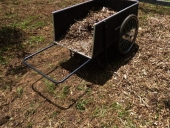I have a back yard about 120 ft square with a slope of about 2.3%. I'm considering manipulating the topography to help accomplish two goals: first, I'd like a large flat area for kids to run around in (ideally with an edible ground cover that takes foot traffic, but that's a question for another forum). Second, I'd like to retain topsoil and control erosion. There seem to be two main options:
1. Import a large 3-D triangle of topsoil and grade so that the yard becomes mostly flat. Then, near the edges, build some combination of diversion ditches and French drains to divert water away from the house and also channeled nicely in such a way as to preserve our topsoil and not create erosion problems for our downhill neighbors.
2. Build a couple of swales on contour and plant them appropriately (with a combination of water-loving plants). Probably import some topsoil anyway, to reduce the slope, but not all the way to level.
I'm not averse to importing topsoil anyway because 95% of the topsoil was removed 12 months ago (before we purchased the property) to clear out a massive bamboo infestation (fence to fence, 25 feet high, 120 feet square, no rhizome barriers). What's left is sandy clay with very poor nutrient content and very low organic matter. We are putting on cover crops to build the soil and reduce erosion, but we may well import some compost and topsoil into this system to increase organic matter content a bit faster. This question is more about what we should consider as we choose to build swales on contour, versus a diversion ditch + French drain, given our goals.
We are in Durham, NC (Zone 7b) with sandy clay soil. In our not very scientific percolation tests, parts of the yard drain pretty fast (less than a minute) and other parts much more slowly (1-2 hours).
In addition to general advice about considerations, I would love to be able to look at some swales and earthworks constructed by other permaculture growers, in our area (Durham / Raleigh / Chapel Hill, if there are growers on this forum who would be willing to give us a brief tour. (Or I also travel quite a bit between NC and Connecticut, so anywhere close to the I-95 corridor could work well also.) I've been studying permaculture off and on for >10 years, but this is both the first time I have land of my own and also the first time I've tried to garden in clay soil, so I'm feeling unexpectedly out of my element.
Many thanks!
Rob




